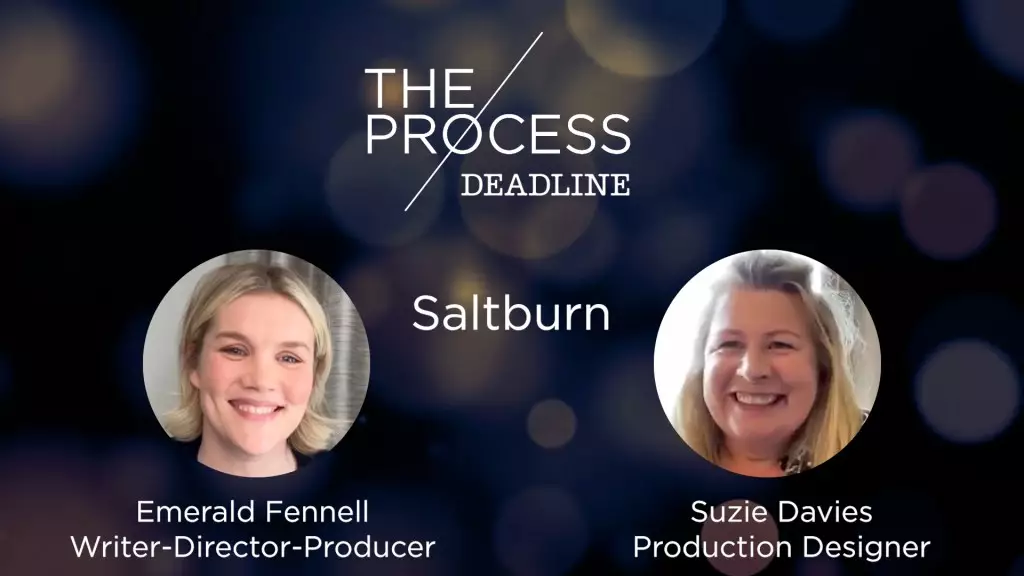The satirical thriller Saltburn, directed by Emerald Fennell, takes place in the luxurious high-society England of the mid-2000s. The film’s production designer, Suzie Davies, understood the importance of accentuating the imperfections within this seemingly perfect world. Davies’ task was to explore the pursuit of the human element within ornate and historic spaces. She accomplished this by filling frames with a mix of eccentric details and beautiful aesthetics, such as “cigarette butts and wotsits and iPod nanos, as well as all the beautiful marquetry and perfect wallpaper.”
The Visual Appeal
Saltburn has gained massive viral appeal, particularly among young viewers, since its release in theaters. The film follows the story of Oliver, an Oxford student who embarks on a journey of social climbing after becoming obsessed with the captivating and aristocratic Felix Catton. The majority of the story takes place in the sprawling and eccentric titular manor, filled with character-based details that make the space feel lived in.
A World Built on Inspiration
Davies, a lifelong lover of character-based stories, draws inspiration from various sources to create the world of Saltburn. From historical references like Caravaggio and the Pre-Raphaelites to contemporary and modern art, she weaves together a tapestry of visual elements that range from the extraordinary to the mundane. Davies describes her approach as being a “magpie and a stealer of other people’s ideas and thoughts,” which allows her to create a world rich in detail and stories.
The Layered Craft of Worldbuilding
Fennell compares the process of worldbuilding to a constant layering up of detail, where each frame tells myriad, very detailed stories. Her collaboration with Davies resulted in a playful and fun atmosphere on set, as they worked with eccentric elements such as a “nine-foot minotaur with a massive willy.” However, Fennell emphasizes that this playfulness was only possible after a period of incredibly hard and diligent work to establish the foundation of the film’s aesthetic.
The Enigmatic Maze
One of the standout sets created for Saltburn was the enormous maze outside of Felix’s family estate, where a crucial encounter between Oliver and Felix takes place. Davies fondly recalls the process of creating the maze, describing it as “proper filmmaking fun.” The maze itself was a product of smoke and mirrors, with an element of a beech hedge used to bring the vision to life. It was essential to find the right balance between romantic and sinister, ensuring it didn’t appear too whimsical or beautiful.
Every aspect of Saltburn was meticulously crafted, with attention to detail being a top priority. The filmmakers enlisted the help of renowned maze designer Adrian Fisher to bring the maze to life. Their goal was to create a practical maze that, even if paused in a top shot, would appear real. Multiple paths were designed within the maze, including a “cheat’s route” and a challenging, diabolically difficult path. Each interior set was layered with visual elements that hinted at subtextual backstory, adding depth and richness to the overall aesthetic.
Saltburn marks Emerald Fennell’s sophomore feature after the success of the Oscar-winning Promising Young Woman. The film premiered at the Telluride Film Festival, generating significant buzz and anticipation. Fennell directed from her own script, while also producing alongside Margot Robbie, Tom Ackerley, and Josey McNamara of LuckyChap. The cast, featuring Rosamund Pike, Richard E. Grant, Alison Oliver, and Archie Madekwe, further elevates the film’s intrigue and appeal.
In their discussion on The Process, Fennell and Davies delve into various aspects of their collaboration. Davies expresses her wish to have built the entire Saltburn on a backlot, highlighting the challenges and benefits of working with physical locations. They also emphasize the value of having a predominantly female crew, which fostered a lovely working atmosphere. Davies’ talent for texture and color and graphic designer Katie Buckley’s exceptional work on the film’s hand-painted stop-motion opening title credits are acknowledged as integral elements of the overall artistic vision.
As Saltburn continues to captivate audiences with its unique blend of beauty and imperfection, the film’s aesthetic stands as a testament to the artistry and vision of Emerald Fennell and Suzie Davies. From the meticulously crafted details to the playful and layered worldbuilding, Saltburn immerses viewers in a visually stunning and narratively engaging experience.

